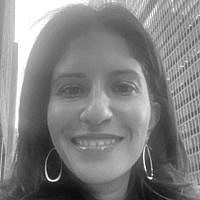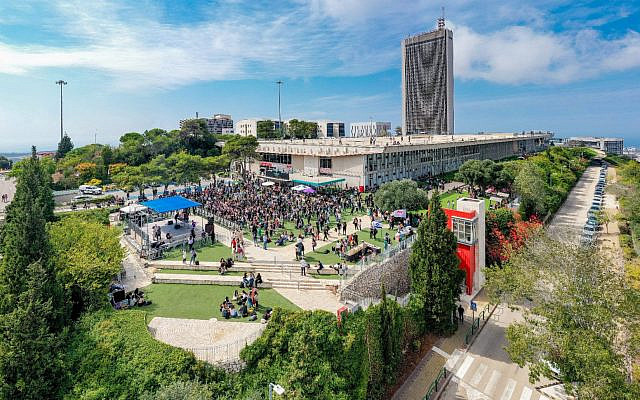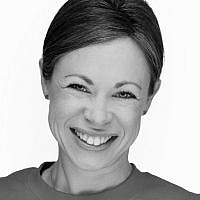What Does the Real Israel Look Like? Look No Further Than This University Campus
What changed for you on October 7?
For so many of us, that “Black Shabbat” and the ensuing months have been defined by a huge range of emotions unlike anything we had ever experienced.
For most of October 7, I was simply trying to understand what was happening in Israel. I was in touch with my family, friends, and colleagues across Israel; I watched the news and devoured social media; I tried to piece together any information I could get. I found out that one of my cousins had attended and miraculously survived the harrowing attack at the Nova music festival.
On October 8, I woke up exhausted, distressed, disoriented, and inconsolable. I spent the day talking to Israeli and Jewish friends in Miami and around the world. I heard that dozens of my cousins would be drafted to the IDF reserves. People I knew started mobilizing rallies, vigils, shipments of equipment and donations, and fundraising drives. I was invited to dozens of new WhatsApp, Telegram, and social media accounts that were tracking the situation on the ground and creating new networks of support. For days, I considered packing my bags and flying to Israel to volunteer in the south myself.
Meanwhile, in the workplace, the October 7 attacks came during my first year as Chief Executive Officer of American Society of the University of Haifa (ASUH). Since then, my colleagues in Israel have been attending funerals and sitting shiva for family and friends, praying for University of Haifa students and faculty members who were kidnapped, and volunteering, helping evacuated families, and enduring rocket attacks in the north.
University of Haifa’s beautiful campus is perched atop the peak of the tallest mountain in the city. Its students, faculty, and staff are the first ones to see a Hezbollah rocket when it penetrates Israeli airspace.
I never imagined that in my first year leading ASUH, I’d be overhauling the organization’s priorities on a moment’s notice and managing urgent fundraising priorities for an Israeli academic institution during a war, and in the aftermath of the deadliest terrorist attack in the country’s history. But here we are.
Some mentors have advised me to stay tough, strong and resilient. Now that I’m a CEO, they say, I must always own that leadership role. However, I am also an Israeli citizen, a family member, a friend, and a colleague. Like everyone else affected by October 7 and the war, I am also human. It’s safe to say that during such challenging and sensitive times, the range of emotions all of us experience, CEOs included, will continue to rise to the forefront and have a significant impact on our daily lives and our ability to embody business as usual.
It’s within precisely this lens that Americans should be viewing Israeli society in the current moment—viewing our counterparts there as simply human. At an institution where almost half of the student body are Israeli Arabs, it should be natural to expect some new tensions following October 7, after months of war and a delayed start to the academic year. However, on Israel’s most diverse campus — where the student body is a mosaic of Jews, Muslims, Christians, Baha’i, Druze, and Bedouins —the understandable fears and anxieties associated with a wartime academic year resulted in only a mere eight suspensions among the 18,000 students. Those suspensions were subsequently overturned. And yet in most of the recent reports about the current climate at University of Haifa, the instinct to give readers the greatest shock value and run with a “sellable headline” took over. Mainstream media ran with headlines such as “War Brings Tensions, and Assault Rifles, Into an Israeli College” and “The war in Gaza is leading to deep divisions at Israeli universities”. The media chose to focus on fear and skepticism among the student body, instead of the resilience, courage, unity, and hope they are exhibiting.
Let that sink in for a moment and ask yourself the following: What would likely occur during a war with our neighbor on an American college campus that has such an equitable proportion of students from backgrounds that are highly susceptible to tensions amongst each other?
In fact, rather than criticize them, American universities can learn a lot from their Israeli counterparts. If Israeli universities are able to avert conflict and refrain from carrying this war over onto their campuses, why can’t American universities do the same? Instead, we’ve seen pro-Hamas rallies, harassment and intimidation of Jewish and pro-Israel students, and college presidents being questioned and resigning, condemned by the United States Congress under Title VI of the Civil Rights Act. So many American universities are miserably failing to provide all students with an environment in which they can be safe and free from discrimination.
And yet, University of Haifa — an institution that finds itself literally in the line of fire — has thoughtfully and proactively navigated current sensitivities in a manner that offers a paradigm to campus communities nationwide and worldwide. The recent few suspensions are not reflective of broader tensions, but rather of a much more harmonious environment than one would expect during a war. That’s the real story. That’s the headline.
I’m delighted to witness how this campus has come together in this extremely difficult time. Students have been clearly demonstrating that the University is strongly positioned to serve as a catalyst for healing between Israel’s different ethnic communities after October 7. During a period of extenuating circumstances, the campus community is not only making the best of the situation, but thriving in the face of adversity.
This fact is a testament to the long-time efforts of the University’s leadership and the work of the University’s new Division for Diversity, Inclusion and Community—serendipitously founded by two female professors — one Arab and one Jewish — on October 5. The Division’s mission is to foster an inclusive, accessible, and safe environment for all students, faculty, and staff through the collective efforts of all university units.
The University was keenly aware that once classes resumed on December 31, the state of harmony that usually characterizes its notably multi-ethnic campus community would be put to the test by concerns stemming from the resurgence of confrontations, the manifestations of incitement and violence, and the challenge of creating a conducive atmosphere for studying in a turbulent and emotionally charged environment. Yet due to the measures put in place by the new division — such as proactive communication to students that helps de-escalate potential tensions, discussion groups at which students from different backgrounds can express their concerns and fears, and the appointment of student volunteers to uphold the values of tolerance and coexistence on campus — tensions between students have been strikingly minimal. In fact, many members throughout the community are now wearing bright orange bracelets with the words “Continuing to Learn Together” emblazoned on them.
For those living in the Diaspora who are primarily following the war through media and social media, it’s crucial to read with a critical eye. The real Israel is what you’d see if you visited University of Haifa’s campus — a beautifully nurtured diverse civic society.
Now, more than ever, is the time to invest in Israeli higher education. If Israel’s students and faculty can overcome the adversity posed by their current situation, they can overcome anything. They demonstrate the impact of a mission that we can all get behind, and they deserve our support, not our criticism.




